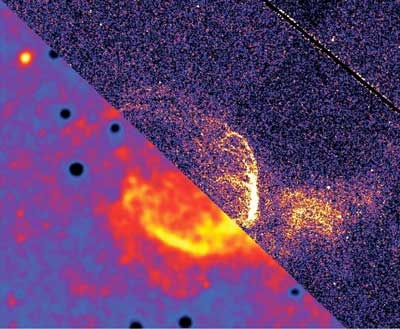| Jan 10, 2019 |
A giant interstellar bubble being blown in the Andromeda Galaxy
|
|
(Nanowerk News) An international team of astrophysicists, including researchers from The University of Manchester’s Jodrell Bank Observatory, have discovered that a remarkable star has been continuously erupting, on an annual basis, for millions of years.
|
|
The star is part of a nova system two and a half million light years away in the Andromeda Galaxy, our nearest large galactic neighbour, and is called M31N 2008-12a (or simply 12a for short).
|
|
Based on new observations, and by using state-of-the-art hydrodynamic simulations carried out at Liverpool John Moores University (LJMU) and Jodrell Bank, the astrophysicists also reveal that these constant eruptions are blowing an enormous, interstellar bubble around the nova.
|
 |
| A composite image of Liverpool Telescope data (bottom left) and Hubble Space Telescope data (top right) of the nova super-remnant. M31N 2008-12a is in the middle of the image. (Image: Matt Darnley / LJMU)
|
|
The eruptions are essentially Earth-sized hydrogen bombs, ejecting material equivalent approximately to the mass of the Moon in all directions at thousands of kilometres per second.
|
|
Professor Tim O’Brien, one of the authors of the study and Professor of Astrophysics and Associate Director of Jodrell Bank Centre for Astrophysics, explains: “Every so often a new star appears in the night sky. Although these have been seen for thousands of years, it is only recently that astronomers have realised they are not always new stars being born, but explosions on very old stars.
|
|
“A small number of these novae have been seen to explode more than once. But this phenomenon is rare and typically the explosions repeat only every decade or more. What makes this discovery so unique is the fact the eruptions recur so often.”
|
|
The two stars that make up the nova system and which the bubble surrounds, are a red giant star, which is larger and more evolved than our Sun, orbiting a white dwarf. A white dwarf is a dead star, about the size of the Earth but with a mass almost one and a half times that of the Sun. It is the fact that these two stars orbit in such close proximity that is the cause of the stellar explosions.
|
|
Professor O’Brien added: “The two stars orbit so closely that matter from the red giant falls onto the surface of the white dwarf. Over the course of a year, this accreted material builds up to the point where it exceeds a critical pressure and explodes. Some material is ejected but the white dwarf is not destroyed and the cycle of accretion and explosion continues.
|
|
“These new observations suggest the explosions have been continuing for millions of years, ejecting material and blowing a gigantic glowing bubble that we see surrounding the central stellar system.
|
|
“But this nova remnant is one hundred times larger than any seen before. In order to convince ourselves that this was even possible, we conducted computer simulations of up to a hundred thousand eruptions. These demonstrate that exactly this sort of gigantic bubble can be constructed gradually, outburst by outburst, over millions of years.”
|
|
Despite its uniqueness and staggering scale, the discovery of this super-remnant may have further significance.
|
|
Dr Matt Darnley, lead author on the study and Reader in Time Domain Astrophysics at LJMU’s Astrophysics Research Institute, added: “Studying 12a and its super-remnant could help is to understand how some white dwarfs grow to their critical upper mass and how they actually explode once they gets there as a ‘Type Ia Supernova’. Type Ia supernovae are critical tools used to work out how the universe expands and grows.”
|
|
Dr Rebekah Hounsell, second author on the study and a post-doctoral researcher at the University of Pennsylvania, was at the Space Telescope Science Institute when she took part in the research. She explains: “Type Ia supernovae are some of the largest explosions in the Universe and our most mature cosmological probes. The recurrent novae M31N 2008-12a is the most likely SN Ia progenitor to date, and provides us with the unique opportunity to study such a system before its final demise.”
|

